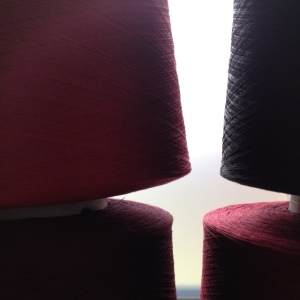26
2014Troubleshooting II: using cotton
 I’ve been exploring a new material: cotton. I have long felt a hesitation towards using cotton on the knitting machine. Woven fabric made of cotton makes a terrific summer cloth. But as cotton has little to no elasticity, knitted cotton fabric tends to grow heavy, loose its shape and make baggy tops and dresses. Not very appealing to me.
I’ve been exploring a new material: cotton. I have long felt a hesitation towards using cotton on the knitting machine. Woven fabric made of cotton makes a terrific summer cloth. But as cotton has little to no elasticity, knitted cotton fabric tends to grow heavy, loose its shape and make baggy tops and dresses. Not very appealing to me.
Still, in summertime you don’t want to wear woollen stuff, you ‘d rather want to feel the airy coolness of cotton on your skin. Consumer yarn is mostly too thick (OK for baggy jumpers). To avoid too much weight the yarn industry adds a certain amount of acryl to the cotton yarn (OK for sweaty sweaters and quickly smelly tops). Thin cotton yarn is often too stiff and won’t drape well (OK for grandma’s crocheted rugs). What to do?
My idea was to use multiple ultimately thin cotton threads. I expected to create an airy, lightweight piece of jersey that way. But where could I possibly buy cotton yarn as thin as sewing thread? Wholesalers only sell by a minimum amount of one ton of yarn. Not within my reach.
I googled around until I bumped into a charming company in the south of The Netherlands that actually sells cotton yarn that thin! And what’s more: they sell it in over a hundred beautiful colours. I thought I found heaven! Since half of my family in law lives in Zuid-Limburg it is not too much of a trouble (the troubleshooting part is yet to come, just read on, dear reader) to combine a visit to heaven with a cup of tea with mom.
After my first visit I came home with four gigantic cones in the most gorgeous tones. Having put them on my storing shelf I couldn’t stop watching them. I dreamed of a cupboard full of these cones in a wide range of colours. What? All colours available of course! On top of it the cotton has been mercerized which gives it a lustrous silky look.
I set to work. To achieve the right thickness I would have to knit with six threads (still looking very thin together!). Here comes my manual yarn winder in: this thin yarn needs to be spooled to smaller bobbins. In order to have six threads for each colour I’ll need five mini bobbins plus the main cone per colour (oops, that makes twenty mini bobbins for me to wind). While my iPod played The Byrds I went Turn! Turn! Turn! Turn!
After that I made several swatches, each in a different gauge. To my big disappointment they all looked like rhombuses where I had expected rectangles. Apparently the yarn had been twisted too strongly. This yarn is not suitable for my plans, it would cause crooked seams. What now? Give up cotton and sell my shiny cones on eBay? No way! I must find a solution.
Like an Alice in Wonderland I took a magnifying glass and minutely studied the colour cards of the southern yarn company. They offer several cotton yarns, each of varying thinness. Nearly all of them have an S-torch but I discovered one organic quality with a Z-torch. When I mix them in the right proportions I must be able to knit rectangles. Theoretically.
On the way to another cup of tea at mom’s I bought a cone of the promising organic Z-cotton. Again I spooled part of it to mini bobbins. This quality is a fraction thicker than the other. Again I made swatches in different proportions. And yes, one of them formed a perfect rectangle, draped well and had that airy grip. One hurray for Lena!
You shouldn’t cheer too early Lena. Don’t you see? Rhombuses you can knit in over a hundred colours, whereas rectangles only in 36. Well, my pencil box also contains 36 colours. That still is a lot, especially when I mix them and create new colours. There is so much more for me to explore!
Troubleshooting may be frustrating and time consuming, troubleshooting also makes you learn and makes you grow. I secretly love troubleshooting. And, dear reader, do have a little patience with me.
PS: The southern yarn company (Venne Colcoton Unikat) is a Valhalla to me after all. They have a weaver’s background. For weavers the extent of Z- and S-torch is not relevant. For knitters it is!